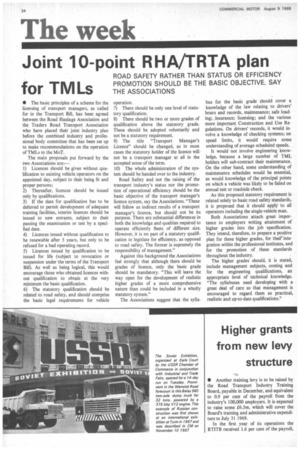H igher grants
Page 36

Page 37

If you've noticed an error in this article please click here to report it so we can fix it.
from new levy structure
• Another training levy is to be raised by the Road Transport Industry Training Board, payable in December, and equivalent to 0.9 per cent of the payroll from the industry's 100,000 employers. It is expected to raise some £6.5m, which will cover the Board's training and administrative expenditure to July 31 1969.
In the first year of its operations the RTITB received 1.6 per cent of the payroll,
equal to £11.5m.
It is the Board's intention to pay higher grants. For on-the-job training the grant rate is to be raised by lOs to £2 a day for trainees under 21; the rate for driver training is to be doubled to £6 per day; and other adult training increased by £1 to £4 a day.
Off-the-job training for drivers is lifted to £10 from £3 a day, with an increase of £4 to £7 a day for other adults.
The yearly grant for apprentices taking a course of further education or off-the-job training is to be increased from £100 to £125, with a daily grant of £3 for every day on which the trainee is released.
Recently increased from £6 to £12 a day for adults training off-the-job, management grants have been further increased to £15 a day with a provision that an extra discretionary grant may be payable where tuition fees are especially high. The normal maximum grant will be £1,500 a year per trainee.
Supplementary grants contributing to the salaries of training officers and instructors have been doubled and travelling and subsistence allowances have been increased by £5 to £20 a week for training carried out more than 40 miles from the normal place of work. New grants of £25 and £40 a week may be paid in respect of distances of over 200 and 500 miles respectively.
Mr. K. C. Turner, chairman of the RTITB, commenting on the new structures said that the Board is now collecting more information about manpower requirements in the industry and this would help to produce more sophisticated proposals next year, possibly leading to differential levy and grant schemes for some sections of the industry.
















































































































































